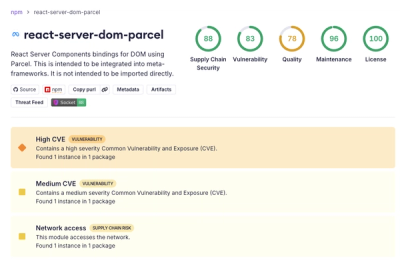
Security News
Deno 2.6 + Socket: Supply Chain Defense In Your CLI
Deno 2.6 introduces deno audit with a new --socket flag that plugs directly into Socket to bring supply chain security checks into the Deno CLI.
@smartrent/express-status-monitor
Advanced tools
Realtime Monitoring for Express-based Node applications
Simple, self-hosted module based on Socket.io and Chart.js to report realtime server metrics for Express-based node servers.

npm install express-status-monitor --saveapp.use(require('express-status-monitor')());/statusNote: This plugin works on Node versions > 4.x
cd examples/npm inpm starthttp://0.0.0.0:3000Monitor can be configured by passing options object into expressMonitor constructor.
Default config:
title: 'Express Status', // Default title
theme: 'default.css', // Default styles
path: '/status',
socketPath: '/socket.io', // In case you use a custom path
websocket: existingSocketIoInstance,
spans: [{
interval: 1, // Every second
retention: 60 // Keep 60 datapoints in memory
}, {
interval: 5, // Every 5 seconds
retention: 60
}, {
interval: 15, // Every 15 seconds
retention: 60
}],
chartVisibility: {
cpu: true,
mem: true,
load: true,
responseTime: true,
rps: true,
statusCodes: true
},
healthChecks: [],
ignoreStartsWith: '/admin'
You can add a series of health checks to the configuration that will appear below the other stats. The health check will be considered successful if the endpoint returns a 200 status code.
// config
healthChecks: [{
protocol: 'http',
host: 'localhost',
path: '/admin/health/ex1',
port: '3000'
}, {
protocol: 'http',
host: 'localhost',
path: '/admin/health/ex2',
port: '3000'
}]

The HTML page handler is exposed as a pageRoute property on the main
middleware function. So the middleware is mounted to intercept all requests
while the HTML page handler will be authenticated.
Example using https://www.npmjs.com/package/connect-ensure-login
const ensureLoggedIn = require('connect-ensure-login').ensureLoggedIn()
const statusMonitor = require('express-status-monitor')();
app.use(statusMonitor);
app.get('/status', ensureLoggedIn, statusMonitor.pageRoute)
Credits to @mattiaerre
Example using http-auth
const auth = require('http-auth');
const basic = auth.basic({realm: 'Monitor Area'}, function(user, pass, callback) {
callback(user === 'username' && pass === 'password');
});
// Set '' to config path to avoid middleware serving the html page (path must be a string not equal to the wanted route)
const statusMonitor = require('express-status-monitor')({ path: '' });
app.use(statusMonitor.middleware); // use the "middleware only" property to manage websockets
app.get('/status', auth.connect(basic), statusMonitor.pageRoute); // use the pageRoute property to serve the dashboard html page
If you're using socket.io in your project, this module could break your project because this module by default will spawn its own socket.io instance. To mitigate that, fill websocket parameter with your main socket.io instance as well as port parameter.
In order to run test and coverage use the following npm commands:
npm test
npm run coverage
MIT License © Rafal Wilinski
FAQs
Realtime Monitoring for Express-based Node applications
We found that @smartrent/express-status-monitor demonstrated a not healthy version release cadence and project activity because the last version was released a year ago. It has 6 open source maintainers collaborating on the project.
Did you know?

Socket for GitHub automatically highlights issues in each pull request and monitors the health of all your open source dependencies. Discover the contents of your packages and block harmful activity before you install or update your dependencies.

Security News
Deno 2.6 introduces deno audit with a new --socket flag that plugs directly into Socket to bring supply chain security checks into the Deno CLI.

Security News
New DoS and source code exposure bugs in React Server Components and Next.js: what’s affected and how to update safely.

Security News
Socket CEO Feross Aboukhadijeh joins Software Engineering Daily to discuss modern software supply chain attacks and rising AI-driven security risks.